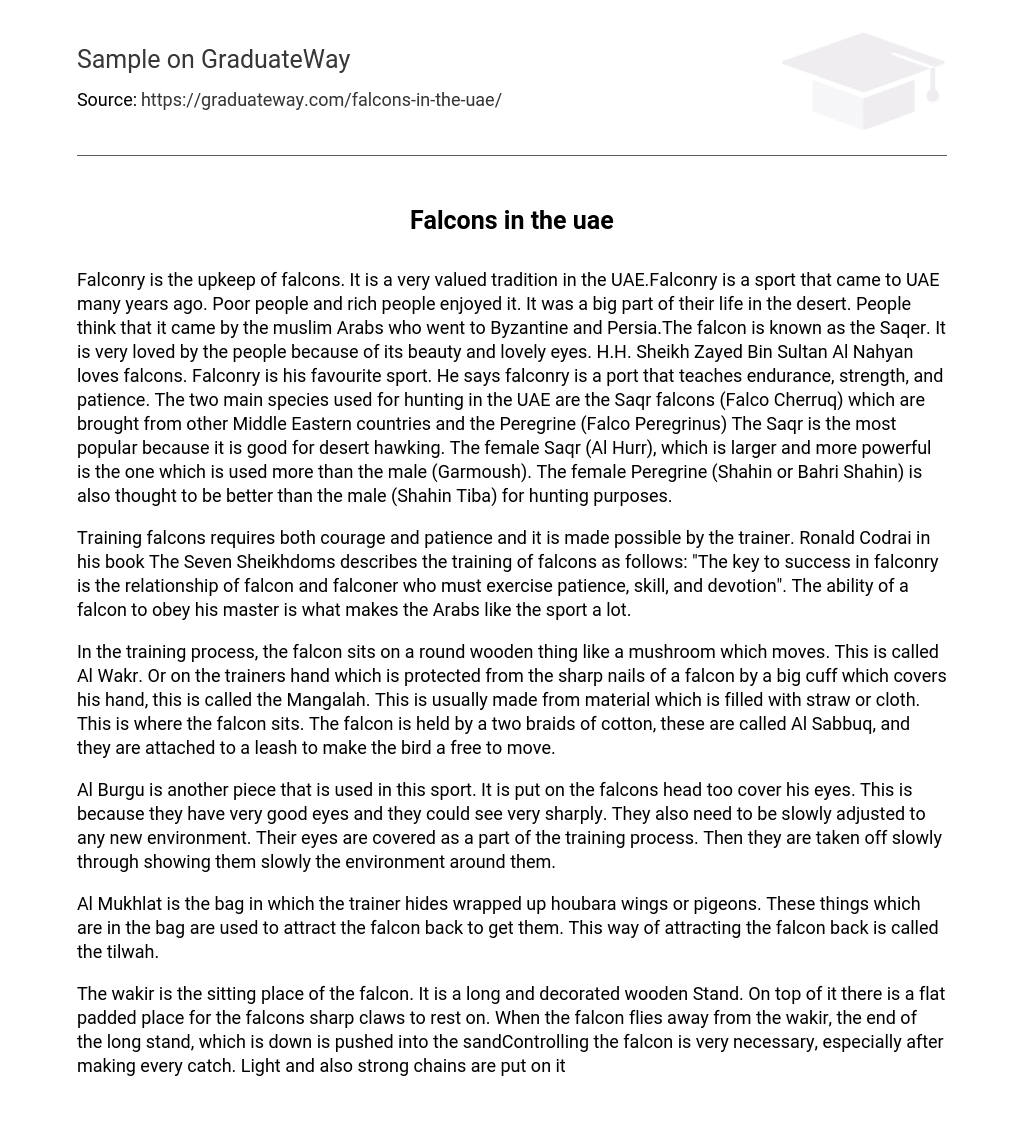Falconry is a treasured tradition in the UAE that involves caring for and preserving falcons. This sport has been practiced by people of all backgrounds, regardless of their wealth, and holds great importance in desert life. Scholars believe that Muslim Arabs who visited Byzantine and Persia introduced falconry to the UAE. The local name for a falcon is Saqer, and its captivating beauty and enchanting eyes have endeared it to the people of the UAE. H.H. Sheikh Zayed Bin Sultan Al Nahyan, an influential figure, particularly loves falcons and considers falconry his favorite sport. He believes that falconry cultivates qualities such as endurance, strength, and patience.
In the UAE, two main species of falcons are commonly used for hunting purposes. The Saqr falcon (Falco Cherruq), which is imported from other Middle Eastern countries, is widely favored for desert hawking. Among the Saqr falcons, the female Saqr (Al Hurr) is larger and more powerful than the male (Garmoush), making it preferred for hunting. Additionally, when it comes to hunting capabilities,the female Peregrine falcon (Shahin or Bahri Shahin) is considered superior to the male (Shahin Tiba).
Training falcons is a task that demands courage and patience, and it is accomplished by the trainer. In his book “The Seven Sheikhdoms,” Ronald Codrai explains that the falconry’s success depends on the relationship between the falcon and its falconer, who must possess patience, skill, and devotion. The Arabs’ fondness for this sport stems from the falcon’s ability to obey its master.
During the training process, the falcon perches on a mobile round wooden object resembling a mushroom, known as Al Wakr. Alternatively, it may sit on the trainer’s hand, which is safeguarded by a large cuff to protect against the falcon’s sharp nails; this is called the Mangalah. Typically, the Mangalah is made of straw or cloth. It serves as the designated resting place for the falcon. The falcon is secured by two cotton braids called Al Sabbuq, which are connected to a leash to allow the bird freedom of movement.
Al Burgu is another piece that is used in this sport. It is placed on the falcon’s head to cover its eyes in order to hinder its sharp vision. The falcons’ exceptional eyesight requires them to adapt gradually to new surroundings. As part of the training process, their eyes are covered and then gradually exposed to the surrounding environment.
Al Mukhlat serves as a concealment for the trainer to house houbara wings or pigeons. These items, kept within the bag, are utilized to lure the falcon back and retrieve them. This technique is known as tilwah.
The wakir is a long and decorated wooden stand where the falcon sits. It has a flat padded area on top for the falcon’s claws to rest on. When the falcon leaves the wakir, the bottom of the long stand is pushed into the sand. It is important to control the falcon, especially after it catches something. The falcon’s ankles are equipped with light and strong chains called subuq. These chains are 30 centimeters long and made of nylon, providing strength and flexibility. The two ends of the chains are tied together and attached to a small ball, known as a mursel. These components allow for easier movement and control of the falcon’s flying.
The falcon shouts “yalla” and, after a short pause, spreads its wings with great force, moving them rapidly and forcefully. It then swiftly ascends into the sky in search of its prey. The pursuit continues for a while until the falcon tires and slows down. It then swiftly descends to the ground, capturing its target.
The falcon’s primary targets are the Houbara or MacQueens bustard, Stone Curlew (Kiriwan), and Hare (Arnab). The Houbara is a sturdy bird weighing up to four kilograms and standing at 75 centimeters tall. Its remarkable speed in both flight and on land brings thrill to falconers during the pursuit.
His Highness Sheikh Zayed is a highly respected authority in the field of falconry. He has been involved in this sport since his youth. In 1976, he wrote an acclaimed book called “Hunting with Falcons,” which is widely recognized as a comprehensive guide to falconry. In the late 1940s, one could purchase a falcon for approximately 120 Dirhams. However, by the 1960s, their price had skyrocketed to around 2,400 Dirhams. At present, these magnificent birds are worth tens of thousands of Dirhams.
The source for the bibliography is www.falcons.com.





